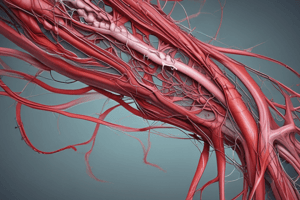Podcast
Questions and Answers
The muscular layer in the wall of a blood vessel is the tunica:
The muscular layer in the wall of a blood vessel is the tunica:
- interna
- intima
- media (correct)
- externa
- adventitia
Compared to arteries, veins:
Compared to arteries, veins:
- are more elastic
- have more smooth muscle in their tunica media
- have thinner walls (correct)
- have a pleated endothelium
- hold their shape better when cut
Capillaries that have a complete lining are called:
Capillaries that have a complete lining are called:
- sinusoidal capillaries
- fenestrated capillaries
- continuous capillaries (correct)
- sinusoids
- vasa vasorum
Venous valves are responsible for:
Venous valves are responsible for:
Factors that increase the risk of atherosclerosis include which of the following?
Factors that increase the risk of atherosclerosis include which of the following?
These vessels may be continuous or fenestrated:
These vessels may be continuous or fenestrated:
Exchange between a blood vessel and the cells that surround it can occur only in:
Exchange between a blood vessel and the cells that surround it can occur only in:
Blood flow through a capillary is controlled by the:
Blood flow through a capillary is controlled by the:
What vessels hold the largest percentage of the blood supply?
What vessels hold the largest percentage of the blood supply?
The only vessels whose walls are thin enough to exchange materials with the surrounding cells are __________.
The only vessels whose walls are thin enough to exchange materials with the surrounding cells are __________.
Arteries have a structure in their middle and internal vessel walls that veins lack, called a/an __________.
Arteries have a structure in their middle and internal vessel walls that veins lack, called a/an __________.
Atherosclerosis is characterized by the buildup of arterial plaque. When plaque first begins to form, on which part of the blood vessel do the monocytes bind after taking in cholesterol-rich lipoproteins?
Atherosclerosis is characterized by the buildup of arterial plaque. When plaque first begins to form, on which part of the blood vessel do the monocytes bind after taking in cholesterol-rich lipoproteins?
Which part of the blood vessel wall is dominated by smooth muscle?
Which part of the blood vessel wall is dominated by smooth muscle?
Vascular resistance is the friction force that opposes blood flow in a blood vessel. What two factors are the most important in generating friction between blood and the walls of a vessel?
Vascular resistance is the friction force that opposes blood flow in a blood vessel. What two factors are the most important in generating friction between blood and the walls of a vessel?
Atherosclerosis has been associated with high blood pressure. What is it called when a person has a blood pressure of 158/99?
Atherosclerosis has been associated with high blood pressure. What is it called when a person has a blood pressure of 158/99?
What is the relationship between high blood pressure and edema?
What is the relationship between high blood pressure and edema?
Total peripheral resistance is related to all of the following except the:
Total peripheral resistance is related to all of the following except the:
Blood pressure is determined by:
Blood pressure is determined by:
Flashcards are hidden until you start studying
Study Notes
Blood Vessel Structure and Function
- The muscular layer in a blood vessel is known as the tunica media.
- Compared to arteries, veins have thinner walls and a less elastic structure.
- Capillaries with a complete lining are referred to as continuous capillaries.
- Venous valves channel blood towards the heart and prevent backflow.
Atherosclerosis Risk Factors
- Key factors increasing the risk of atherosclerosis include obesity, smoking, high cholesterol, and lack of exercise. All contribute cumulatively to the condition.
Capillary Characteristics
- Capillaries can be either continuous or fenestrated.
- Exchange between blood and surrounding cells occurs exclusively in capillaries.
- Blood flow through capillaries is regulated by precapillary sphincters.
Blood Volume Distribution
- Veins hold the largest percentage of the blood supply within the circulatory system.
- The only blood vessels with walls thin enough for material exchange are capillaries.
Structure Differences Between Arteries and Veins
- Arteries have an elastic membrane in their middle and internal walls, which is absent in veins.
- The beginning formation of arterial plaque occurs when monocytes bind to the endothelial lining after ingesting cholesterol-rich lipoproteins.
- The tunica media is the layer of blood vessel walls dominated by smooth muscle.
Vascular Resistance and Blood Pressure
- Vascular resistance depends mainly on blood vessel diameter and length, impacting friction against blood flow.
- A blood pressure reading of 158/99 qualifies as stage 1 hypertension.
- High blood pressure increases capillary hydrostatic pressure (CHP), leading to filtration exceeding reabsorption, contributing to edema.
Total Peripheral Resistance
- Total peripheral resistance is influenced by blood viscosity, vessel diameter, turbulence, and vessel length but not osmolarity of interstitial fluids.
Blood Pressure Measurement
- Blood pressure is typically measured by estimating the pressure required to occlude an artery with an external cuff.
Studying That Suits You
Use AI to generate personalized quizzes and flashcards to suit your learning preferences.




